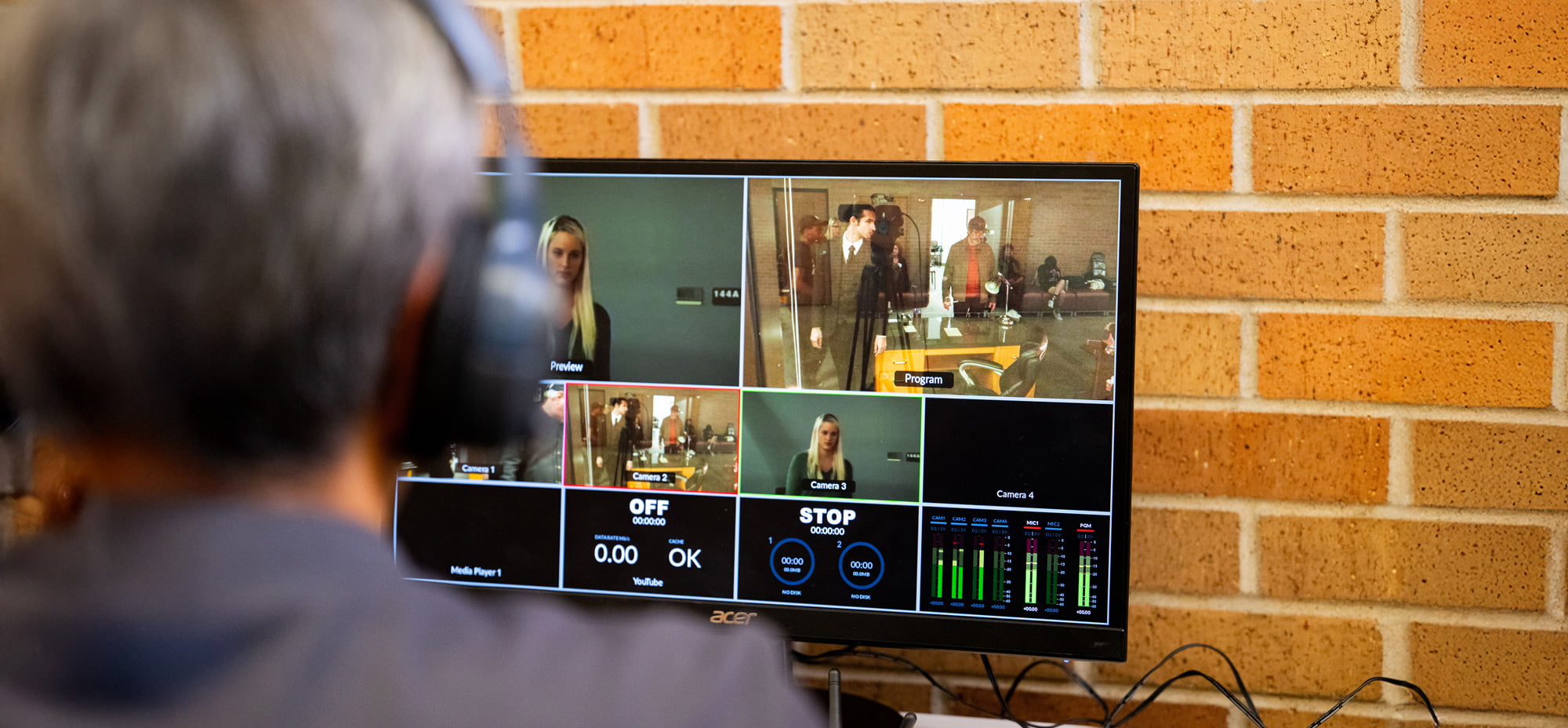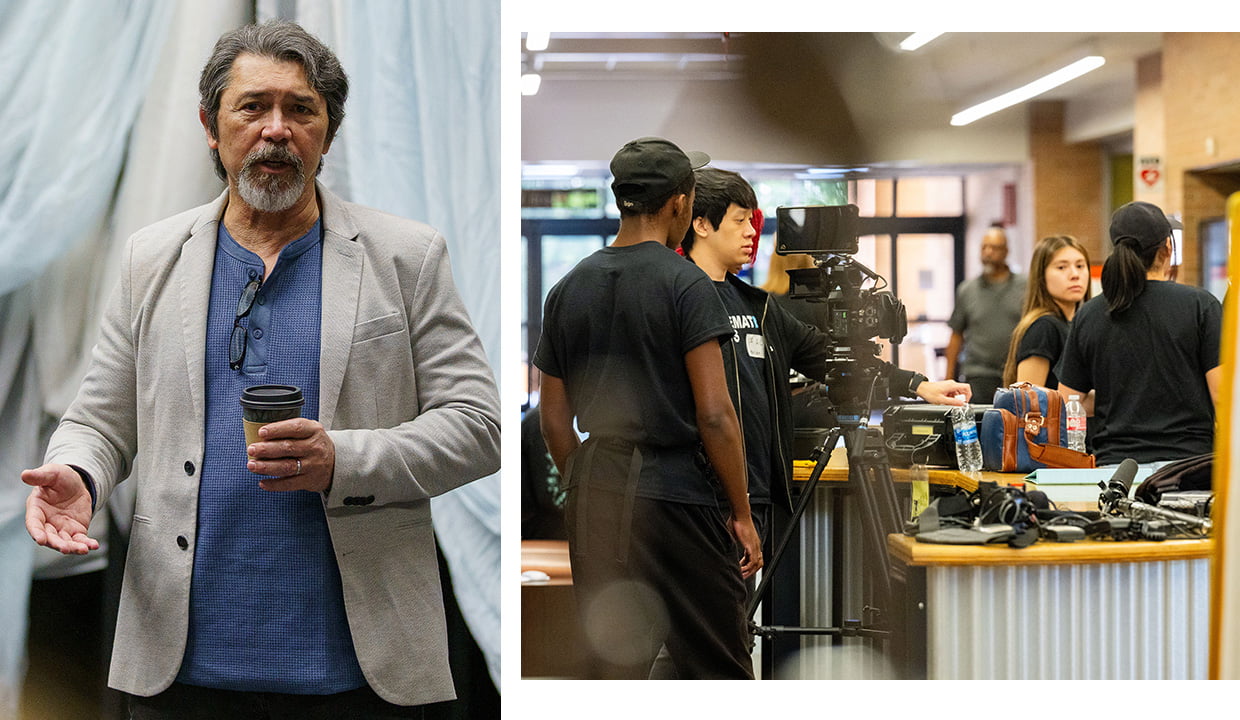University Administration Building
701 S. Nedderman Drive, Ste 421
Arlington, TX 76019-0116
Picture Perfect
Picture Perfect
INT. EDITING ROOM, UT ARLINGTON CAMPUS – DAY
A dimly lit room hums with the soft whir of computers. A group of STUDENTS huddles around a glowing monitor, eyes wide with anticipation. Papers clutter the desks, storyboards are taped to the walls, and empty coffee cups are stacked precariously.
On the screen, a scene from a student film plays out—a YOUNG ACTOR delivers lines with fervor, and the camera slowly zooms in, capturing every nuance of emotion.
The students murmur excitedly, exchanging nods and notes as they see how each cut and splice brings their vision to life. They aren’t just students; they’re artists in the making, shaping stories that could change the world.
A PROFESSOR (50s, passionate, wise) leans over one student’s shoulder, offering guidance.
PROFESSOR
Remember, the magic happens in the details. You’re not just editing; you’re crafting a story.
The STUDENT nods, inspired, and the professor moves on, offering a pat on the back. This is more than a class—it’s a cinematic training ground where passion meets precision.
NARRATOR (V.O.)
At The University of Texas at Arlington, the Cinematic Arts Program is not just about learning the craft of filmmaking. It’s about redefining what it means to be a storyteller in the digital age. Here, innovation meets inspiration, and Mavericks create narratives that move audiences around the world.
DISSOLVE TO: THE BACKGROUND
In 2023, the Texas legislature set aside $200 million in incentives to encourage more filmmakers to bring their productions (and massive budgets) to Texas. The law includes clauses that will benefit the studios if they hire a certain percentage of the film crew and background actors from the local areas. It’s the highest amount the state has ever allocated toward The Texas Moving Image Industry Incentive Program, and UTA saw the pledge as a tremendous opportunity not only for the state, but for its students.
“With the implementation of film tax incentives in Texas, our program saw a unique chance to benefit both our students and the state. These incentives enable our students to participate in significant productions without leaving Texas, providing them essential hands-on experience,” says August Davis, chair of the Department of Art and Art History. “In turn, this prepares them to contribute meaningfully to the state’s burgeoning film industry. And by tailoring our curriculum to leverage these new opportunities, we’re fostering a new wave of filmmakers who will help position Texas as a premier destination for film and television production.”
According to Cinematic Arts Program administrators, the Fort Worth Film Commission and the Dallas Film and Creative Industries Office have already started conversations with UTA and other universities to help facilitate the proper preparation of students as the big studios roll into North Texas.
“Our program is really at an exciting place. Collaborations with local film organizations are opening up extraordinary opportunities for our students right here in North Texas,” says Dr. Davis. “These connections, combined with our dynamic curriculum and top-notch facilities, are propelling our program to new heights.”

CUT TO: THE PROGRAM
The Cinematic Arts Program in the Department of Art and Art History fosters a community devoted to storytelling through the cinematic art form. The young filmmakers in the program are trained and mentored on theory and technique under a studio art model, and their skills are refined in a well-balanced three-tiered program so students can learn and cultivate technical and aesthetic principles, hone narrative skills, and produce high-quality, portfolio-ready work.
As students move through the program, they’re immersed in all aspects of making a film, including directing, cinematography, editing, screenwriting, motion graphics, and much more. Students explore different areas of filmmaking—animation, documentary, live-action, commercial, video arts, and narrative—and go on to specialize in the direction best aligned with their passions and career goals.
“Storytelling is what sets us apart from a lot of other film institutions,” says Patty Newton, co-area coordinator of cinematic arts, assistant professor of practice, and a filmmaker whose work has been screened at film festivals all over the world. “We teach the gadgetry and everything that goes into filmmaking, but it doesn’t matter if you have the best camera and a top crew if you don’t have a story.”
Bart Weiss, an award-winning filmmaker, educator, and director/founder of Dallas VideoFest, recently retired as a cinematic arts professor after teaching in the program for 25 years. He explains that because there is an emphasis on storytelling, students make films that come out of their experiences and aren’t simply replicating the styles of Hollywood.
Weiss, who also produces Frame of Mind, a long-running PBS series highlighting independent filmmakers in Texas, notes that the program is more pragmatic because it’s in the Department of Art and Art History. There is more time spent in the classroom per day, honing skills through practice, collaboration, and mentorship.
“I think we push our students, because if I’m going to recommend someone for a shoot, I need to know they are going to show up on time and do something well,” he says. “We are harder on them because it’s hard to make a living in this business. It’s a tough industry, so we have to be tough from the start.”
SMASH CUT TO: REAL-WORLD EXPERIENCE
During the fall 2023 semester, Emmy award-winning director Norry Niven (’85 BA, Film) and actor Lou Diamond Phillips (’85 BFA) returned to UTA to host a weeklong teaching residency for students in both cinematic arts and theater arts. Their goal was to ignite the passion of the next generation of filmmakers and actors aspiring to enter the industry.
As part of the residency, the alumni worked with students from both areas in an all-day film shoot. Angel Rodriguez, an upcoming graduate and aspiring cinematographer, was part of the crew on set.
“There were moments on set when Norry and Lou would take a minute and explain to us why they do things or tell us stories of crew members not being up to standard on set,” Rodriguez says. “It was an awesome experience because it was very much like being on a professional set, and this kind of stuff prepares you for when we’re out in the real world.”
This importance of experiential learning is why Changhee Chun, the Morgan Woodward Distinguished Professor, created The Maverick Film Production company. The company, which provides high-quality media production services to UTA and clients in the Dallas-Fort Worth area, is staffed by students, with Chun serving as the director. Currently, the company takes on about 50 productions per year.
“I train my students to apply what they learn in the class to our client-based productions,” says Chun, an international award-winning filmmaker. “We have weekly workshops to train students and to also learn new techniques like live streaming, advanced camera operations or editing, visual effects—basically whatever is needed for our production service.”

Right: Students collaborate while setting up a scene.
MATCH CUT TO: TELLING THEIR OWN STORIES
Another way the program prepares its students is to allow them to make their own films and use their own voices.
“Since we rely on the foundation of storytelling, our classes are centered on a project where each student needs to tell a story,” says Daniel Garcia, co-area coordinator of cinematic arts and a Peruvian filmmaker whose own work has been shown internationally. “They can be taking a film theory class or a directing class, but they have to write a screenplay, go through the process, and we want to see it on the screen at our end-of-semester film showcase.”
For students like Rodriguez, these experiences are key. When he transferred to UTA his sophomore year, he knew UTA was going to be a good place to become an immersive and innovative storyteller.
“I became fascinated with film through watching the behind-the-scenes videos included in DVDs, specifically the one for The Lord of the Rings,” says Rodriguez. “The thing that would captivate me the most was how the showrunners were able to build a world, and I liked seeing how they did it. That was why I picked up a camera and never looked back.”
For Brian Tran, every film project is an opportunity to learn something new. He describes it as taking an ambitious approach and giving himself the chance to work with new gear, use new techniques, and continue perfecting his skill.
“I won’t ever be able to guarantee I know how to do everything, which is why I like to experiment and give myself a chance to say I’ve tried something,” he says.
Joshua Gallas (’18 MFA, ’14 BFA, Art) an Emmy Award-winning director and co-founder of Prelude Films, feels it’s important to only pursue stories that he can see himself in.
“I strive to challenge an audience, and everything that I make is to have people think and to sit there and wonder,” Gallas says. “To me, the best movies are the ones that create an emotional response that needs time to process after the credits start rolling.”
Recent graduate Xoe Cano (’24 BFA, Film) says the Cinematic Arts Program challenged her to step outside of her comfort zone and tackle projects that would take her skills to the next level.
“I chose filmmaking so that I could explore themes that meant more to me and try to take more risks with my storytelling,” says Cano. “Taking a risk, going beyond a little box, and exploring themes that really mean something to me is what’s helped me find my real place as a storyteller.”
FADE OUT TO: THE FUTURE
After student films are completed, faculty members are also there to help students navigate the festival circuits. There is a craft to selecting the right festivals to submit films to, says Weiss. As a major player in the game, he even taught a class on the ins and outs of festivals.
“The local film festivals have frequently curated their shows using our students’ films,” says Newton. “So have film festivals outside the state and beyond.”
In fact, UTA faculty, alumni, and student films have been curated into major festivals like South by Southwest, Cannes, Berlin International, Munich International, and several more. Each year, when UTA filmmakers showcase their work at local and statewide film festivals, they are always among the Best in Show.
Davis notes that the accolades are almost a given at a university where innovation, real-world experience, and collaboration ensure graduates are not only well-prepared to succeed in their careers, but also to become influential voices in the world of cinema.
“As our Cinematic Arts Program continues to grow and evolve, we remain committed to nurturing the next generation of filmmakers and storytellers who will shape the future of the industry,” she says. “We are incredibly proud of the achievements of our students and alumni and look forward to the exciting stories they will bring to life in the years to come.” 



